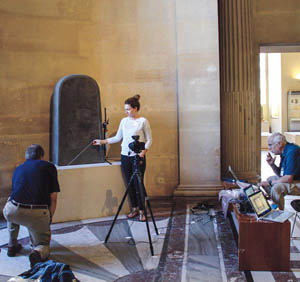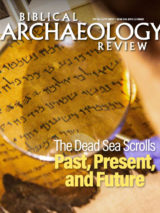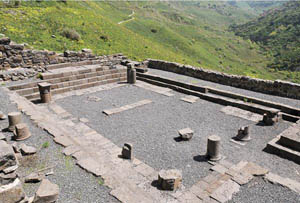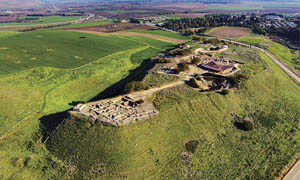Mesha’s Stele and the House of David

In 2015, a team of researchers journeyed to the Louvre Museum to photograph the Mesha Stele using Reflectance Transformation Imaging (RTI). RTI combines multiple images, taken with light shining from different angles, to create a textured map of an object’s surface. Here, Kyle McCarter (left), Heather Parker (center), and Bruce Zuckerman (right) work to create an RTI image of the stela. Image by West Semitic Research Mesha’s Photo Shoot.
More than 150 years after its discovery, the Mesha Stele remains one of the most important West Semitic inscriptions and probably the one that sheds the most light on the Hebrew Bible. As many BAR readers know, the inscription was discovered in 1868 at the site of Dhiban (biblical Dibon), east of the Dead Sea in modern-day Jordan. After an intriguing but unfortunate series of events, the stela was broken into several pieces shortly after its discovery, which required French archaeologist Charles Clermont-Ganneau to restore the text based on the recovered fragments and a paper squeeze that was made just before the stela was damaged.a The stela, which was eventually restored and displayed in the Louvre Museum, was first erected in the ninth century B.C.E. by Mesha, king of Moab. The 34-line text provides confirmation of key biblical figures and events from the early years of the divided monarchy, with numerous references to the Northern Kingdom of Israel, its founder King Omri, and the competing gods of Israel and Moab, Yahweh and Chemosh.
Despite the inscription’s importance and uniqueness—rivaled perhaps only by the famous Tel Dan Stele discovered in 1993—many questions remain about its content, especially whether the expression btdwd, “House of David” (bt meaning “house of” and dwd meaning “David”) can be found in a fragmented and particularly poorly preserved portion of the text. While I (Lemaire) first proposed this reading nearly three decades ago, based on paleographic and contextual considerations (especially the text’s internal parallelism and the date and content of the Tel Dan Stele),b improved photographic evidence has allowed scholars to gain new insights into the stela’s most problematic sections. These insights, which we discuss here, not only confirm that the Mesha Stele references the “House of David” but also allow us to draw new conclusions about the various historical and biblical events described in the text.

Dibon Map
Over the past few years, new digital imaging techniques have greatly advanced our understanding of the stela’s paleography, especially since the inscription’s heavily damaged and fragmented left side has long made certain key sections unreadable. The paper squeeze, made before the stela was damaged, is the only direct witness of its original condition and was used by Clermont-Ganneau to restore the damaged sections. In 2015, a team from the West Semitic Research Project of the University of Southern California took new digital photographs of both the restored stela and the paper squeeze. The team used a method called Reflectance Transformation Imaging (RTI), in which numerous digital images are taken of an artifact from different angles and then combined to create a precise, three-dimensional digital rendering of the piece.c This method is especially valuable because the digital rendering allows researchers to control the lighting of an inscribed artifact, so that hidden, faint, or worn incisions become visible.1 In 2018, the Louvre Museum also took new, high-resolution backlit pictures of the squeeze, where light was projected directly through the 150-year-old paper to provide a clearer view of the ancient letters it records.2

Mesha’s home. The Mesha Stele tells how King Mesha expanded the kingdom of Moab and made Dibon (above) his capital in the ninth century B.C.E. Dibon (modern Dhiban) sat on the King’s Highway, the major trade route in the region that brought spices up from the south. As King Mesha’s capital, Dibon was the place where he set up his victory stela. Here, you can see remains of the city’s wall and other structures. Archaeologists have uncovered fortifications, a palace, and a sanctuary from the ninth century B.C.E. Courtesy of ACOR, The Jane Taylor Collection.
Based on this new photographic evidence, we believe that five key letters, found in line 31 of the inscription, can be read as btdwd. First, it is important to note that the bet (first letter) and the waw (fourth letter) were already clear on both the stone and the squeeze and, therefore, accepted by most scholars even prior to the new photographs. As such, we focus our discussion on what the new images reveal about the preserved traces of the second, third, and fifth letters (see supporting images in “A Close Look” sidebar).
The traces of the second letter, which we interpret as a taw, remain unclear on the stone, although a faint diagonal line coming down from the left as well as the beginning of the upper right portion of the cross-stroke seem to be visible. The backlit photograph of the squeeze shows traces of three tips of an X-shaped letter, with no signs of any vertical or diagonal stroke extending below the line. While we acknowledge that this reading remains uncertain, the identification of a taw is the best reading based on the available evidence.
The next letter, dalet, is lost due to a break in the stone, but it does appear on the squeeze. The traces of two strokes forming an angle are clear in the backlit photograph, where a short, upward stroke meets a long, nearly horizontal stroke at a slightly acute angle. Although the rest of the letter remains vague, its general outline seems to be triangular, suggesting either a resh or a dalet. The length of the nearly horizontal stroke, combined with the absence of a vertical or diagonal stroke below this line, are highly suggestive of a dalet rather than a resh. In fact, faint traces of a triangular letter appear on the RTI images of the squeeze, establishing with practical certainty that the third letter is dalet.

Mesha in a new light. The Mesha Stele chronicles the victories of King Mesha of Moab over Israel and Judah. It was discovered in Dibon in 1868 and broken into many pieces shortly afterward. Later, Charles Clermont-Ganneau recovered many of the pieces and reassembled the stela. Before it was divided, though, Yaqub Karavaca was able to make a squeeze (paper-mache impression) of it. In 2018, a new backlit picture of the squeeze was created (shown here). The “House of David” (btdwd) reference in line 31 is highlighted. © Musée Du Louvre, Dist. Rmn-Grand Palais/Philippe Fuzeau/Art Resource, NY
The fifth and last letter follows the undisputed waw and is clear enough on the stone and the squeeze, even though the left angle of the triangular-shaped letter is slightly damaged. The new images confirm previous readings, as three lines meet to form the upper and lower angles of a triangle, while the left angle is missing. This character is now generally accepted as a second dalet.

Mesha in a new light. The Mesha Stele chronicles the victories of King Mesha of Moab over Israel and Judah. It was discovered in Dibon in 1868 and broken into many pieces shortly afterward. Later, Charles Clermont-Ganneau recovered many of the pieces and reassembled the stela. The “House of David” (btdwd) reference in line 31 is highlighted in this image. © Rmn-Grand Palais/Art Resource, NY
Further support for the reading btdwd, “House of David,” comes in the form of two small, dot-shaped word dividers, which define this idiom as a single unit. The first one is undisputed and clearly appears before the bet, while the second one has generally been overlooked, since it appears at the beginning of a badly damaged section toward the end of the line. Though slightly damaged, the dot does show up on the RTI images of the stone and the squeeze as well as on the backlit photograph following the second dalet. Additionally, no word divider is used between bt and dwd, which matches the orthography in the Tel Dan Stele, though there it is found with the Aramaic spelling bytdwd.
Therefore, the new photographs clearly establish the presence of the first dalet and confirm the last dalet, while only the letter taw remains somewhat unclear. Given this and the presence of word dividers before and after this five-letter unit, we believe the reading btdwd is confirmed once and for all.3

The Tel Dan Stele tells of the victories of a foreign king, most likely King Hazael of Aram, over the kingdoms of Israel and Judah during the ninth century B.C.E. The king boasts of killing King Joram of the Northern Kingdom of Israel and King Ahaziah of the “House of David” (highlighted in white), meaning the Southern Kingdom of Judah. This text parallels the biblical account in 2 Kings 8–9. Archaeologists found the stela, written in Aramaic script, at Tel Dan in northern Israel. It is now on display at the Israel Museum. Zev Radovan/Biblelandpictures.com
The confirmed presence of btdwd in the Mesha Stele offers important insights into the history of the Kingdom of Judah, especially regarding its political identity and the extent of its political hegemony. The idiom “House of David”—now firmly identified in both the Tel Dan and Mesha inscriptions—mirrors the names of several Aramaic and Levantine kingdoms that use bt (“house of”) to preface the name of the dynasty’s founding ruler (e.g., House of Adini, House of Agusi, House of Omri). This nomenclature, which is attested primarily from the tenth to eighth centuries B.C.E., defined political authority in terms of kinship and, more specifically, as the rule of the house (or royal dynasty) of the eponymous founder who was remembered across generations as the patriarchal “father” of the kingdom. Modern scholars have termed such polities “patrimonial kingdoms,” as they were often decentralized and preserved the authority of the founder’s dynasty by appealing to kinship while giving political prominence to leading local families.
The presence of “House of David” in the Mesha Stele further implies that the territory of the Kingdom of Judah extended across the Dead Sea and included some areas of Transjordan, at the very least during the ninth century B.C.E. In particular, we now read in lines 31–33 of the inscription: “As for Horonain, the House of David dwelt in it … and Chemosh said to me: ‘Go down, fight against Horonain! I went down, [fought against the city and took it.]” 4 While the precise location of Horonain (biblical Horonaim) remains disputed, Chemosh’s command to Mesha to “go down,” as well as references to Horonaim in the Bible (Isaiah 15:5-6; Jeremiah 48:3-5, Jeremiah 48:34) and in the Jewish historian Josephus’s writings (as Oronaim, see Antiquities 13.397), all suggest the area southeast of the Dead Sea, somewhere in the valley or hills leading up to the Moabite plateau. Wherever it was located, Horonain must have played a role in controlling the lucrative trade routes coming from Edom and the Arabah.d
Although it is difficult to know for certain when the House of David first began to “dwell” in Horonain, this likely happened in the tenth century B.C.E., during the reign of David, or in the first half of the ninth century B.C.E., during the reign of Jehoshaphat. The latter may have supported the economic and military expansionist policies of the kings of the Northern Kingdom of Israel (Omri and Ahab) in Transjordan. Dating the withdrawal of the House of David from Horonain and Moab is, on the other hand, directly related to our understanding and dating of the Mesha Stele as well as the events it describes.
Historical allusions throughout the text provide us with specific temporal anchors. Line 6 clearly implies that Mesha was already king of Moab at the death of Ahab (c. 853 B.C.E.). The text further insinuates that Mesha witnessed the end of the Omride dynasty through a clear reference to Jehu’s coup in 842/841 B.C.E.: “I gloated over him and his house” (line 7). Mesha also claims that “Israel was utterly destroyed forever” (line 7), a probable allusion to the catastrophic situation prevailing in Israel during the reign of Jehoahaz, son of Jehu, when the Northern Kingdom was under intense pressure from Hazael, king of Aram-Damascus (2 Kings 13:7, 2 Kings 22). The stela must, therefore, date to the time of Jehoahaz (c. 810–805 B.C.E.), and was erected by Mesha in his capital of Dibon toward the end of a long and successful reign.
This date stands in direct contrast to most traditional interpretations of the stela, which have sought to link the Mesha inscription with the events surrounding Mesha’s rebellion related in 2 Kings 3. In fact, the two texts are unrelated and tell of two different conflicts. Mesha first initiated a war of independence to control the core territory of Moab. This is reflected in the account found in 2 Kings 3, where Israel and Judah act together to invade Moab in response to Mesha’s rebellion and eventually fail to conquer Qir-Hareshet (probably Kerak, a major site in central Moab). Once Mesha consolidated his power, he initiated an offensive and expansionist war, benefitting from the pressure applied by Hazael on the Northern Kingdom of Israel.
The stela does mention the conquests of foreign territories north of the Arnon River (Wadi Mujib), as well as the absence of any real military opposition. Thus, the conquest of Horonain must have taken place either concomitantly with the campaign of Hazael in northern Transjordan (c. 830 B.C.E.; 2 Kings 10:32-33) or with the siege of Gath, the leading city of Philistia, after which Joash of the Southern Kingdom had to pay tribute to spare Jerusalem from destruction (c. 810 B.C.E.; 2 Kings 12:18-19). The weakening of the political influence of Judah was then considerable, with its boundaries reverting back to its core territory in the southern highlands.
The Mesha Stele also sheds light on many other aspects of southern Levantine history that cannot be dealt with here. Our focus has been to investigate the new photographs taken in 2015 and 2018 to settle an old epigraphic debate. We conclude that they confirm the reading btdwd, “House of David,” in line 31 of the inscription. This reading offers important insights into the history of the Kingdom of Judah, especially regarding its political identity and hegemony. Another thing is clear: The Mesha and Tel Dan inscriptions suppose the existence of an established West Semitic royal scribal tradition before 800 B.C.E. But this is the subject of another discussion.
A Close Look at the “House of David”
The Mesha Stele, a ninth-century B.C.E. inscription from Moab, details the victories of King Mesha of Moab over the kingdoms of Israel and Judah. The stone might contain a reference to btdwd, “House of David” (bt meaning “house of” and dwd meaning “David”) in its 31st line. Although this reading has been contested, new images of the stone and of the squeeze (papier-mâché impression of the stone) confirm the reading “House of David.” In the below images, full lines represent a safe reading, while the dashed lines refer to reconstructed parts of letters for which no clear traces appear on the stone or the squeeze.

An RTI photo of the stela showing the btdwd section. Copyright West Semitic Research/A. Lemaire–J.-P. Delorme

An RTI photo of the stela with the letters bt_wd (the initial dalet is lost) and dot-shaped word dividers highlighted in red. Copyright West Semitic Research/A. Lemaire–J.-P. Delorme
RTI Photo of Stela
Top: an RTI photo of the stela showing the btdwd section.
Bottom: the same photo with the letters bt_wd (the initial dalet is lost) and dot-shaped word dividers highlighted in red.

An RTI photo of the squeeze showing the btdwd section. Copyright West Semitic Research/A. Lemaire–J.-P. Delorme

An RTI photo of the squeeze with the letters btdwd highlighted in red. Copyright West Semitic Research/A. Lemaire–J.-P. Delorme
RTI Photo of Squeeze
Top: an RTI photo of the squeeze showing the btdwd section.
Bottom: the same photo with the letters btdwd highlighted in red.

A backlit photo of the squeeze showing the btdwd section. Copyright West Semitic Research/A. Lemaire–J.-P. Delorme

A backlit photo of the squeeze with the letters btdwd and dot-shaped word dividers highlighted in red. Copyright West Semitic Research/A. Lemaire–J.-P. Delorme
Backlit Photo of Squeeze
Top: a backlit photo of the squeeze showing the btdwd section.
Bottom: the same photo with the letters btdwd and dot-shaped word dividers highlighted in red.
Notes
1. See Michael Langlois, “The Kings, the City and the House of David on the Mesha Stele in Light of New Imaging Techniques,” Semitica 61 (2019), pp. 23–47, esp. pp. 24–26 for the RTI images.
2. See Isabel Bonora Andujar, “L’estampage de la stele de Mésha,” in Thomas Römer, ed., Mésha et la Bible (Paris, Collège de France, 2018), pp. 28–33.
3. Several scholars contest this reading on various grounds, but we believe their arguments are unfounded. See Matthieu Richelle, “A Re-Examination of the Reading BT DWD [House of David] on the Mesha Stele,” in Hillel Geva and Alan Paris, eds., Ada Yardeni Volume, Eretz-Israel 34 (Jerusalem: Israel Exploration Society, 2021), pp. 152*–159*; Israel Finkelstein, Nadav Na’aman, and Thomas Römer, “Restoring Line 31 in the Mesha Stele: The ‘House of David’ or Biblical Balak?” Tel Aviv 46 (2019), pp. 3–11; Nadav Na’aman, “The Alleged ‘Beth David’ in the Mesha Stele: The Case Against It,” Tel Aviv 46 (2019), pp. 192–197.
4. For more, see André Lemaire, “The Mesha Stele: Revisited Text and Translation,” in Meir and Edith Lubetski, eds., Epigraphy, Iconography, and the Bible (Sheffield: Sheffield Press, 2022), pp. 22–23.
a. Siegfried H. Horn, “Why the Moabite Stone Was Blown to Pieces,” BAR, May/June 1986.
b. André Lemaire, “‘House of David’ Restored in Moabite Inscription,” BAR, May/June 1994.
c. Bruce E. Zuckerman, Archaeological Views: “New Eyeballs on Ancient Texts,” BAR, November/December 2011; Todd R. Hanneken, Archaeological Views: “Digital Archaeology’s New Frontiers,” BAR, March/April 2017.
d. See Thomas E. Levy and Mohammad Najjar, “Edom & Copper,” BAR, July/August 2006.
Current Issue
Must-Read Free eBooks
Other Magazine Highlights
Jesus in the Synagogue
Who Lived at Hazor?
Unlock Unlimited Access to the Bible's Past
Become an All-Access Member to explore the Bible's rich history. Get Biblical Archaeology Review in print, full online access, and FREE online talks. Plus, enjoy special Travel/Study discounts. Don't miss out—begin your journey today!








